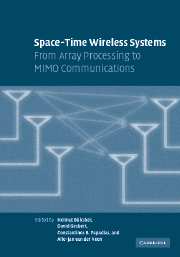Book contents
- Frontmatter
- Contents
- List of contributors
- Acknowledgments
- Introduction
- Part I Multiantenna basics
- Part II Space-time modulation and coding
- Part III Receiver algorithms and parameter estimation
- Part IV System-level issues of multiantenna systems
- Part V Implementations, measurements, prototypes, and standards
- 23 What we can learn from multiantenna measurements
- 24 Experiments in space-time modulation and demodulation
- 25 Multiple antenna techniques in 3G wireless systems
- 26 MIMO wireless local area networks
- 27 VLSI implementation of MIMO detection
- Index
23 - What we can learn from multiantenna measurements
Published online by Cambridge University Press: 25 February 2010
- Frontmatter
- Contents
- List of contributors
- Acknowledgments
- Introduction
- Part I Multiantenna basics
- Part II Space-time modulation and coding
- Part III Receiver algorithms and parameter estimation
- Part IV System-level issues of multiantenna systems
- Part V Implementations, measurements, prototypes, and standards
- 23 What we can learn from multiantenna measurements
- 24 Experiments in space-time modulation and demodulation
- 25 Multiple antenna techniques in 3G wireless systems
- 26 MIMO wireless local area networks
- 27 VLSI implementation of MIMO detection
- Index
Summary
Why multiantenna measurements?
“The propagation channel is at the heart of any wireless system; it sets the ultimate limits for other fields of wireless communications engineering.”
Nowhere is this statement more true than in MIMO systems. The MIMO radio channel crucially determines the characteristics of the entire system. It forms the basis upon which system engineers and signal processing specialists can build MIMO systems. Multiantenna measurements serve to characterize the MIMO propagation channel. We need them to construct models of MIMO transmission, to validate our models, but also in operation to obtain information at the transmitter (Tx) and receiver (Rx) sides about the current channel (channel state information, see Chapter 6). Detailed knowledge about wave propagation has clarified information-theoretic viewpoints and inspired new MIMO models.
We will touch on pros and cons of some measurement methods, and point out some common pitfalls when interpreting measurements. We will highlight calibration, mutual coupling, normalization, and the question of what to consider as an appropriate ensemble of data points. How do the antenna arrays compound the environment to the MIMO channel, and which limits does the radio channel impose on the MIMO communication system? Precise information about the spatio-temporal characteristics of the environment (“clustering”) bears a wealth of information, some of which is still untapped. Spatial correlation and spatial stationarity are important characteristics that multiantenna measurements provide us with. An example of validation of MIMO channel models through experiments will reveal the benefits and shortcomings of some common performance figures.
- Type
- Chapter
- Information
- Space-Time Wireless SystemsFrom Array Processing to MIMO Communications, pp. 467 - 486Publisher: Cambridge University PressPrint publication year: 2006

